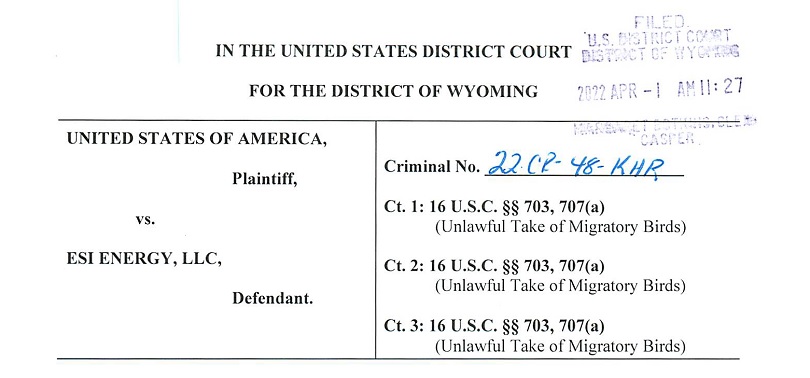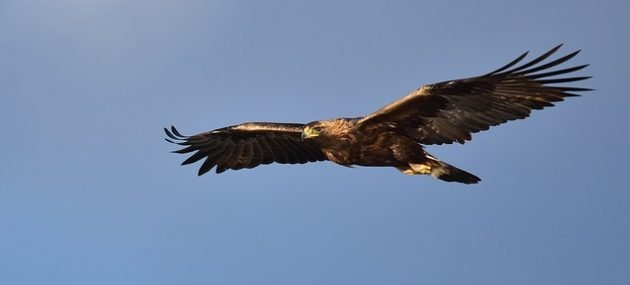
A wind energy company recently pleaded guilty to multiple violations of the Migratory Bird Treaty Act (MBTA) and agreed to pay approximately $8 million in fees and restitution. For the next five years, it must also implement an Eagle Management Plan. The company, ESI Energy LLC, built facilities in high-risk locations, failed to obtain permits, and its wind turbines killed approximately 150 eagles.
Although this bottom line summary may be sufficient for many birders, a brief description of the how the process works may be interesting to others.
To begin the case, the U.S. Department of Justice filed a “criminal information” (i.e., a formal document identifying the charges) against ESI in the U.S. District Court for the District of Wyoming in April 2022. The information is 17 pages and it details the facts underlying the charges.
Broadly summarizing, the information alleges that ESI violated the MBTA and the Bald and Golden Eagle Protection Act by failing to secure permits for several of its facilities in Wyoming. It alleged that ESI hired consultants that informed ESI that Golden Eagles were observed at proposed sites and that eagle strikes were likely, and that ESI executives knew these facts.
It further alleges that the U.S. Fish and Wildlife Service (FWS) told ESI that there were an “unusually high number of occupied golden eagle nests” and that the facility should not be built at the proposed location. But if it was built, ESI should obtain an eagle take permit. There were similar additional communications as well. But ESI built facilities at these high-risk locations and it did not obtain permits. Eagle carcasses were found at these locations when operations began.
Additionally, the information alleges that these actions were “taken under a nationwide posture and corporate policy of not applying for” eagle take permits:
At no time did ESI or any of its subsidiaries or affiliated companies or their personnel or agents apply for or obtain any ETP authorizing the killing or wounding of any eagles relating to any of its wind power facilities, including for the killing or wounding of any of the 136 eagles listed below. ESI and its affiliates deliberately elected not to apply for or obtain an ETP intended to ensure the preservation of bald and golden eagles, and instead chose to construct and operate facilities it knew would take eagles, and in fact took eagles, without any permits authorizing that take.
Moreover, because some other wind energy companies did obtain permits and agreed to follow best practices to avoid killing eagles, ESI achieved a competitive advantage over those competitors.

As a result, “[s]ince 2012, there were at least 150 documented eagle deaths at 50 of defendant’s 154 wind power facilities in the United States. The actual number was probabilistically higher, as studies have established that even with rigorous monitoring, which was not conducted at all facilities nor at all relevant times, not all carcasses are found.”
Just a few days after the information was filed, ESI pleaded guilty and the sentence in the plea agreement was imposed. A formal judgment was filed the next day, on April 6, 2022. That judgment identifies the charges and the plea and specificies the sentence, i.e., the unsupervised probation (i.e., an eagle management plan), financial penalties, and restitution. All of this had likely been negotiated before the case was filed. (The docket, which is a list of the documents filed in the case, is here.)
The Department of Justice press release stated:
ESI pleaded guilty to three counts of violating the Migratory Bird Treaty Act (MBTA), each based on the documented deaths of golden eagles due to blunt force trauma from being struck by a wind turbine blade at a particular facility in Wyoming or New Mexico, where ESI had not applied for the necessary permits. ESI further acknowledged that at least 150 bald and golden eagles have died in total since 2012, across 50 of its 154 wind energy facilities. 136 of those deaths have been affirmatively determined to be attributable to the eagle being struck by a wind turbine blade.
The penalties were substantial:
The court sentenced ESI, pursuant to a plea agreement, to a fine of $1,861,600, restitution in the amount of $6,210,991, and a five-year period of probation during which it must follow an Eagle Management Plan (EMP). The EMP requires implementation of up to $27 million… of measures intended to minimize additional eagle deaths and injuries, and payment of compensatory mitigation for future eagle deaths and injuries of $29,623 per bald or golden eagle. ESI also must over the next 36 months apply for permits for any unavoidable take of eagles at each of 50 of its facilities where take is documented or, in the case of four facilities not yet operational, predicted.
However, notwithstanding its guilty plea, the company issued a rather defiant press release: “Unfortunately, the federal government, at odds with many states and a number of federal court decisions, has sought to criminalize unavoidable accidents related to collisions of birds into wind turbines while at the same time failing to address other activities that result in far greater numbers of accidental eagle and other bird mortalities.”
Nevertheless, it will pay penalties, implement an EMP, and its parent corporation will apply for permits for its other wind facilities.
Note that this outcome would not have been possible had the Trump Administration’s proposed changes to “incidental take” been implemented.
Photos: Golden Eagle by Tom Koerner/USFWS Mountain-Prairie.













Very nice write-up. Good to see a relatively quick result under the two acts. The Altamont pass litigation in California has been a legal morasse.